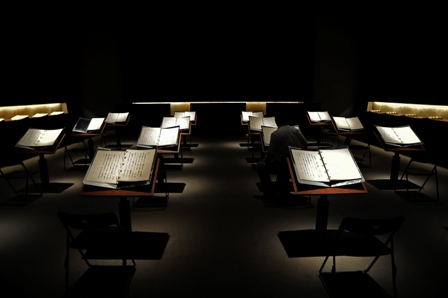
We began the day in Naha with lattes, a pastry translated as “the bomb,” and a skip across the parking lot to a tiny religious site tucked in by the port. As part of the Ryūkyū kingdom until “assimilated” by Japan during the Meiji, there are celebrated remnants of Ryūkyū religion here. However, my uneducated eye can’t tell Ryūkyū from Buddhist from Shinto, although the differences between these Okinawan shrines and those on Honshu are noticeable. We came upon a group of older people placing offerings at the shrine, with the woman reading from a printed script. Apparently there is an attempt here to resurrect the Ryūkyū culture as we see in Hawaii with its native resurgence.
For our first jaunt of the day we drove south to the tip of the island and the Okinawa Prefectural Peace Memorial Museum. The park complex is constructed at the site where the Japanese military finally surrendered to the Americans at the end of the Battle of Okinawa.
That horrific bloodletting lasted 82 days, with a price of at least 200,000 lives (at least half of them Okinawan civilians). The park and museum quietly reinforce the idea that war is madness, and you cannot leave here without that notion made brutally clear. Particularly moving were the walls with the names of the dead, a reflection of (and inspired by) the Viet Nam war memorial in Washington D.C. The park also reminded me of the International Peace garden that straddles the U.S and Canadian border in the Turtle Mountains, with its manicured gardens and tall spire at the end of a mall.
One cannot visit Okinawa and escape the shadow of the war. My father, who is alive and well at 85, served on a DE on the way to Okinawa to prepare for the invasion of Japan. The war, in effect, came to an end here, and the Okinawans themselves paid most dearly for being precisely at the wrong place at the wrong time. The exhibits in the museum document their sufferings, culminating in a room with nothing but the written remembrances of Okinawans who survived the hell of that battle.
The history of war is most often written as a series of discrete events, memorializing battles between well-defined enemies and celebrated leaders. We honor the warriors, and deify their commanders. What is lost is such a narrative are the lives of the countless civilians who are victimized by war. Where are the people who simply wished the war would go away; common people who are displaced, suffer, and die in these conflagrations? Okinawa, Tokyo, Hiroshima, Nagasaki, Dresden, Hamburg, Nanking, Manchuria, the World Trade Center, and Baghdad are among the countless killing fields of peoples who committed no crime, and who wished only for what our founders demanded as “life, liberty, and the pursuit of happiness.” Nowhere is that truth more evident than Okinawa.
After a quick bowl of soba (Okinawan style, with a thicker noodle), we began the trek to the northern end of the island. Once past the urban maze of the south (and Naha) we soon were enveloped by small farms and villages; the Okinawa I wanted to experience for myself. Fields of corn and sugar cane, bitter melon vines, the bristling tops of pineapples plants, and the curious bush-topped stalks of papayas painted the landscape.
Only in the hinterlands did we also begin to see native Okinawans, people whose Mongol heritage comes through in their shorter stature and darker skin. Many had features that reminded me of Koreans, and, during the Ryūkyū era, Okinawa, Korea, and China enjoyed extensive trade. As I have seen throughout Japan, these farms are models of manicured care. No square inch goes to waste, and their postage stamp farms are meticulously tended. How nice to spend an afternoon driving through rural Okinawa without seeing the detritus of everyday life (abandoned double wides, half-stripped automobiles, roadside McDonald hamburger wrappers) that characterizes much of the rural Texas countryside (particularly the coast).
Mr. Iwama, our dear friend and tour guide, wanted to show us the Kesaji mangrove forest in the village of Higashi. This small park had a nice boardwalk through the mangroves, and a bustling kayak rental business that filled the waters with shrieking young girls this Saturday afternoon.
For my birder friends, I did see a few familiar species, although this trip is not one where birding is taking the front seat. I have deprived my family too many times of my attention and presence during these types of trips as I sauntered off chasing birds, so I am trying to make up for lost time. I did see familiar birds such as Blue Rock Thrush, Yellow Wagtail, Chinese Bulbul, and Japanese Whiteeye. As we walked along a stream at Kesaji we were treated to a Common Kingfisher whizzing by in an iridescent azure blur.
After our mangrove hike we drove a short distance to the Marriott Okinawa resort, where we treated ourselves to a night of tourist pampering. Mr. Iwama and I began the evening with a couple of glasses of the local rice drink – Ayamori. Served over ice, Ayamori is sake on steroids. While sake is brewed, Ayamori is distilled (think about the difference between pulque and tequila). Dinner at the hotel consisted of many local dishes, including a salad of umi budo (seaweed that resembles strands of green grapes), kimchee, beni imo (the Okinawan purple yam), and another Okinawan specialty, shima tofu.
Ted
15 Mar 2010